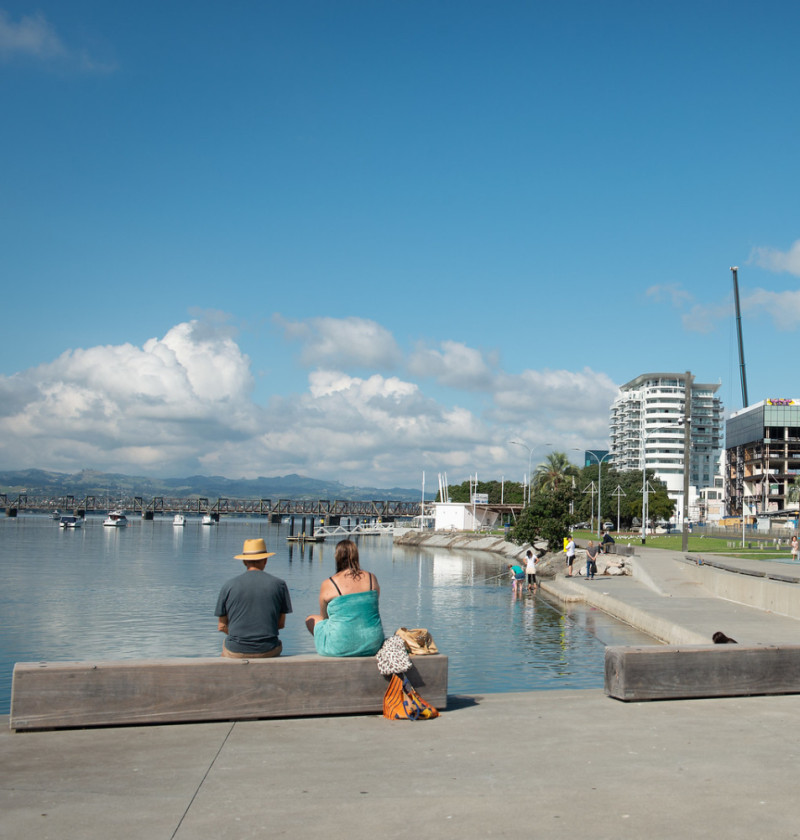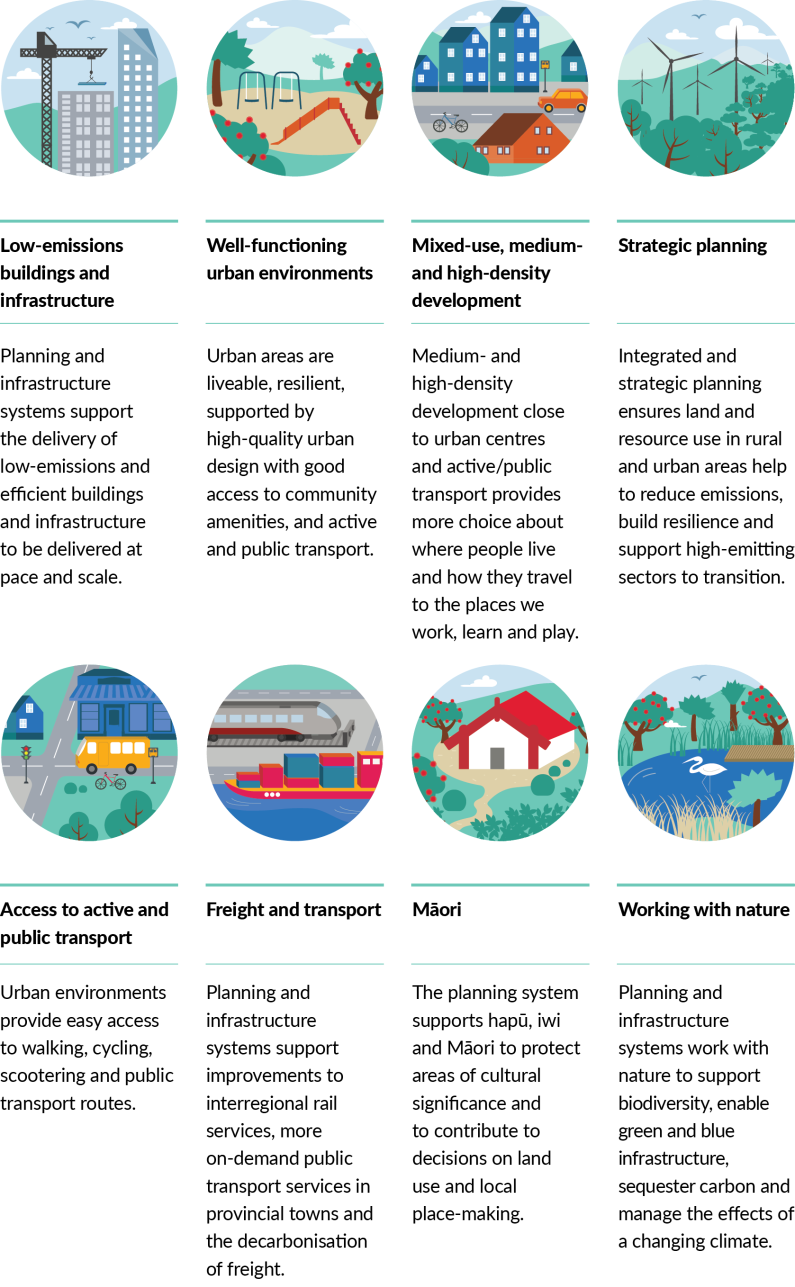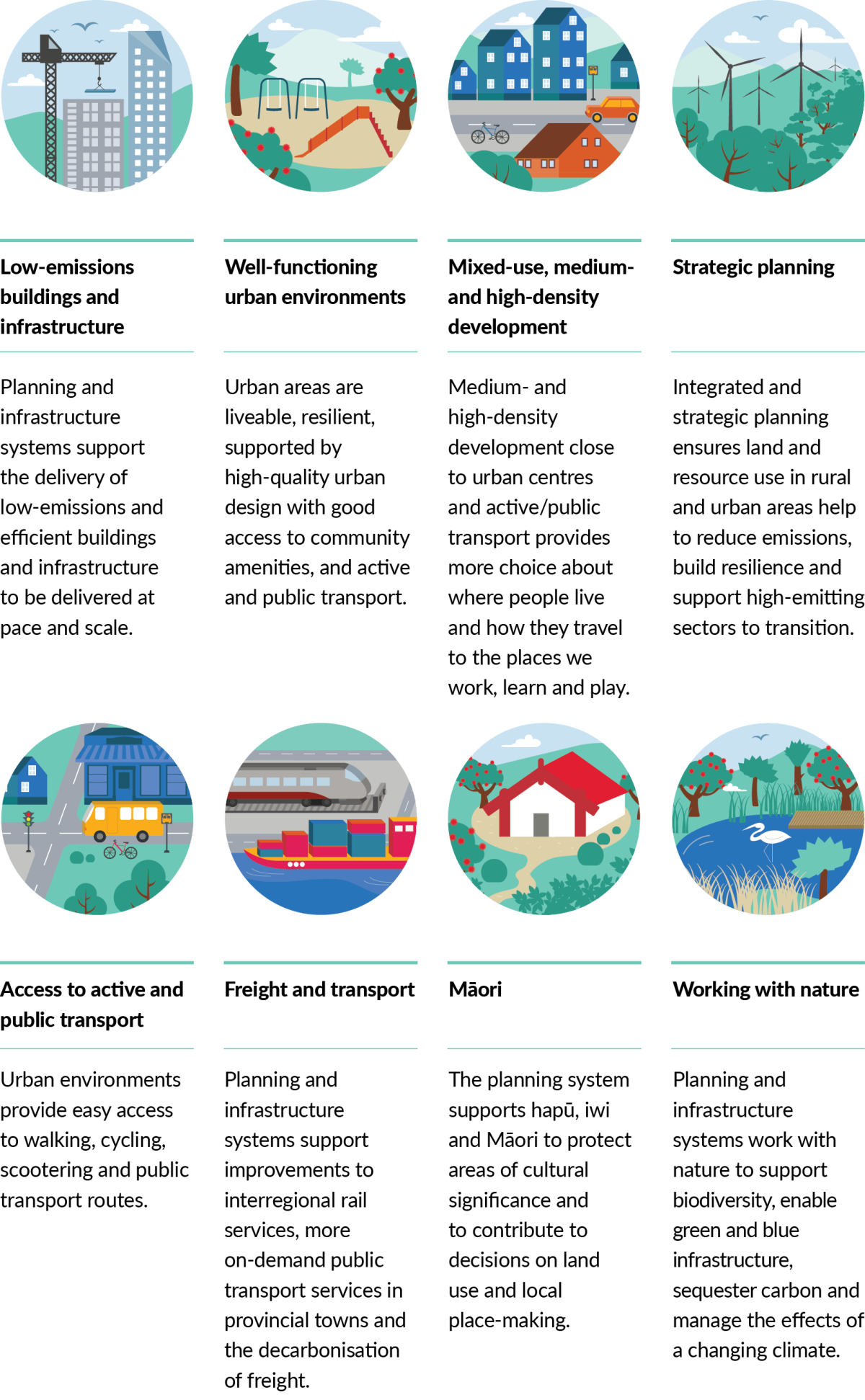Chapter 7 Planning and infrastructure


Download a PDF version of this chapter [PDF, 840 KB]
The development of planning, investment in infrastructure, and land and resource management will help to identify opportunities (and remove barriers) to meeting emissions budgets and 2050 targets, while also building climate resilience and improving people’s wellbeing.
How we use land and other natural and physical resources impacts on our greenhouse gas emissions and determines how well we cope with the effects of climate change. Decisions we make about land use, resources and infrastructure now will determine our emissions pathway well into the future.
The planning and infrastructure systems guide decisions on how we use our land and natural and physical resources. They also guide infrastructure investment. These decisions influence the form, location and type of development that takes place.
They have long-term impacts due to the lifespan of the built environment. These decisions cover investment and planning processes for infrastructure, including the development of new infrastructure, and significant renewals or major upgrades of existing assets.
Decisions about when, where and how to invest in infrastructure services should be outcome focused, align with national objectives* and consider built and non-built solutions.
* These strategic objectives (from deciding when, where and how to invest in infrastructure) are set out across a range of regulatory and policy frameworks, including:
Getting the foundations of our planning and infrastructure systems right today will help our towns and cities generate fewer greenhouse gas emissions in the future. The right planning and infrastructure settings will also ensure we are resilient to the impacts of climate change and help people and nature to thrive.
Over many decades, our towns and cities have been planned in ways that often lead to businesses, communities and households participating in activities that create emissions and make it harder for them to do things that avoid or reduce emissions. Many major infrastructure decisions have not adequately taken climate change into account.
We need to change the way we use our land and resources and plan, build and operate infrastructure, to support our transition to a low-emissions, resilient society over the next 30 years. To achieve that goal, we need to enable our planning and infrastructure systems to reduce emissions, increase removals and improve climate resilience now.
Our planning and infrastructure systems influence how and where our towns and cities grow. They shape how decisions are made on the types of infrastructure provided and how infrastructure is funded, financed and used.
When infrastructure and planning decisions are made in an integrated way, informed by national objectives, they can help us achieve well-functioning, low-emissions urban environments, while enabling us to use our land and resources more carefully and efficiently.
Urban environments with a variety of mixed-use, medium- and high-density development that is connected to urban centres, as well as active and public transport routes, will help reduce greenhouse gas emissions. That is partly because they provide more options for people to travel between where we work, live, play and learn.
Well-planned urban areas provide an opportunity to realise wider benefits too. They enable a greater supply and diversity of housing to be built at pace and scale, improving affordability. Good access to active and public transport routes that safely take people to workplaces and education centres can provide greater access to learning and job opportunities for households, improve public health and wellbeing and strengthen community cohesion.
How we provide infrastructure also affects our emissions. Higher-density, mixed- use developments can have lower operational emissions per dwelling and allow infrastructure to be used more efficiently, avoiding or delaying the need for more infrastructure and associated emissions.
Non-built solutions to our infrastructure needs – including nature-based solutions – can also reduce the need for built infrastructure made of materials that carry embodied emissions. They can also help to sequester carbon, improve indigenous biodiversity and create more liveable environments that encourage people to walk or cycle, reducing emissions from transport.
Decisions about investment in infrastructure need to take account of the whole-of-life costs and benefits of that investment, including the cost of emissions associated with that infrastructure.
The planning and infrastructure systems can also help to prevent development in areas vulnerable to the impacts of climate change, such as flooding. Avoiding development in these areas will help us reduce the need for additional infrastructure to protect vulnerable land and assets – saving on emissions from building new infrastructure – and avoid the need to replace or relocate existing infrastructure and buildings.

The Wellington Regional Leadership Committee (the Committee) is an Urban Growth Partnership for the Wellington-Wairarapa-Horowhenua area. The Committee is planning for growth that will support the transition to a resilient, low-emissions economy. This collaboration between local councils, central government and mana whenua aims to improve coordination and alignment for housing, land use, transport, climate change and emissions and infrastructure planning.
In July 2021 the Committee finalised the Wellington Regional Growth Framework (the Framework), the region’s first joint spatial plan. The Framework describes a 30-plus-year vision for how the region will grow and change and the enabling infrastructure needed to accommodate an additional 200,000 people and 100,000 jobs, making best use of assets and resources, and achieving resilience and emissions reduction.
The Framework supports denser urban forms in locations that are well connected with active and public transport and ensures that new growth areas are well located, use land efficiently and are more self-supporting, with local employment and community facilities.
Our planning and infrastructure systems need to support emissions reductions across a range of sectors.

Low-emissions buildings and infrastructure
Planning and infrastructure systems support the delivery of low-emissions and efficient buildings and infrastructure to be delivered at pace and scale.
Well-functioning urban environments
Urban areas are liveable, resilient, supported by high-quality urban design with good access to community amenities, and active and public transport.
Mixed-use, mediumand high-density development
Medium- and high-density development close to urban centres and active/public transport provides more choice about where people live and how they travel to the places we work, learn and play.
Strategic planning
Integrated and strategic planning ensures land and resource use in rural and urban areas help to reduce emissions, build resilience and support high-emitting sectors to transition.
Access to active and public transport
Urban environments provide easy access to walking, cycling, scootering and public transport routes.
Freight and transport
Planning and infrastructure systems support improvements to interregional rail services, more on-demand public transport services in provincial towns and the decarbonisation of freight.
Māori
The planning system supports hapū, iwi and Māori to protect areas of cultural significance and to contribute to decisions on land use and local place-making.
Working with nature
Planning and infrastructure systems work with nature to support biodiversity, enable green and blue infrastructure, sequester carbon and manage the effects of a changing climate.

Low-emissions buildings and infrastructure
Planning and infrastructure systems support the delivery of low-emissions and efficient buildings and infrastructure to be delivered at pace and scale.
Well-functioning urban environments
Urban areas are liveable, resilient, supported by high-quality urban design with good access to community amenities, and active and public transport.
Mixed-use, mediumand high-density development
Medium- and high-density development close to urban centres and active/public transport provides more choice about where people live and how they travel to the places we work, learn and play.
Strategic planning
Integrated and strategic planning ensures land and resource use in rural and urban areas help to reduce emissions, build resilience and support high-emitting sectors to transition.
Access to active and public transport
Urban environments provide easy access to walking, cycling, scootering and public transport routes.
Freight and transport
Planning and infrastructure systems support improvements to interregional rail services, more on-demand public transport services in provincial towns and the decarbonisation of freight.
Māori
The planning system supports hapū, iwi and Māori to protect areas of cultural significance and to contribute to decisions on land use and local place-making.
Working with nature
Planning and infrastructure systems work with nature to support biodiversity, enable green and blue infrastructure, sequester carbon and manage the effects of a changing climate.
Getting the fundamentals right for the next 30-plus years, and ensuring decisions taken today will not hold us back, is critically important for placing Aotearoa New Zealand on a low-emissions pathway to meeti ng the 2050 target.
Significant reform to the resource management system – which will help to embed necessary changes to the way we manage land and resources – has already begun. The new system will have an impact on emissions reductions beyond the first emissions budget period.
Together, the package of initiatives outlined below will:
The resource management system will be improved to support emissions reductions and climate resilience.
Among other things, the new resource management system will:
To reduce emissions, we need more energy-efficient, mixed-use urban development at medium and high densities, supported by active and public transport. A range of initiatives are underway in partnership with local government, Māori and the private sector that promote housing and development that will help deliver low-emissions and climate-resilient urban environments. It is important that housing and urban development also support accessibility for those living with a disability.
The Government will address funding and financing challenges for delivering infrastructure investment that supports urban development and to use infrastructure funding and financing tools in a way that helps to reduce emissions.
The Government will look to improve the evidence base and tools to better understand the emissions from urban development and infrastructure. These improvements could inform future frameworks for reducing those emissions.
To demonstrate how to deliver low-emissions, liveable neighbourhoods, the Government will:
To further accelerate the development by the private sector of medium- and high-density development, the Government will:
To ensure that government infrastructure investment decisions properly consider emissions reduction and the need to adapt to the effects of climate change, the Government will:
Local government and the private sector have a role to play in ensuring that our planning system and investment in infrastructure support our transition to a low-emissions and climate-resilient society.
Local government engages with local community and tangata whenua to help inform decisions it makes on land use, resource management, urban form, road and transport services, infrastructure funding and servicing, waste management, flood risk management and coastal management.
The private sector funds, finances, designs, constructs, delivers and maintains much of the built environment. This includes developers; community housing providers; infrastructure providers; and those in the finance, building and construction, architecture, engineering sectors.

Chapter 7 Planning and infrastructure
May 2022
© Ministry for the Environment